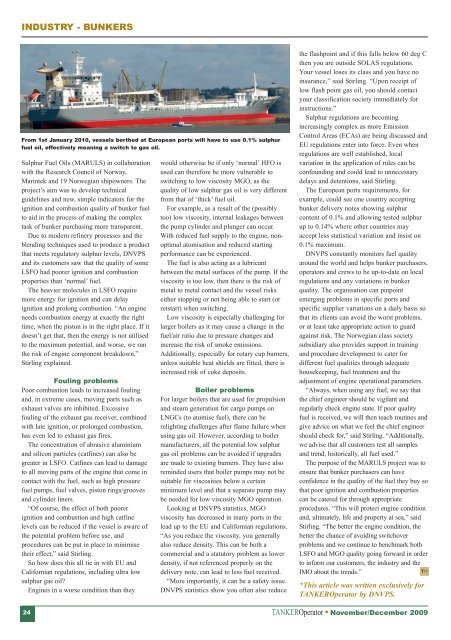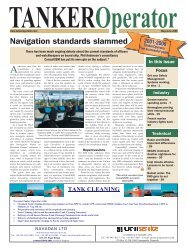Features: - Tanker Operator
Features: - Tanker Operator
Features: - Tanker Operator
Create successful ePaper yourself
Turn your PDF publications into a flip-book with our unique Google optimized e-Paper software.
INDUSTRY - BUNKERS<br />
From 1st January 2010, vessels berthed at European ports will have to use 0.1% sulphur<br />
fuel oil, effectively meaning a switch to gas oil.<br />
Sulphur Fuel Oils (MARULS) in collaboration<br />
with the Research Council of Norway,<br />
Marintek and 19 Norwegian shipowners. The<br />
project’s aim was to develop technical<br />
guidelines and new, simple indicators for the<br />
ignition and combustion quality of bunker fuel<br />
to aid in the process of making the complex<br />
task of bunker purchasing more transparent.<br />
Due to modern refinery processes and the<br />
blending techniques used to produce a product<br />
that meets regulatory sulphur levels, DNVPS<br />
and its customers saw that the quality of some<br />
LSFO had poorer ignition and combustion<br />
properties than ‘normal’ fuel.<br />
The heavier molecules in LSFO require<br />
more energy for ignition and can delay<br />
ignition and prolong combustion. “An engine<br />
needs combustion energy at exactly the right<br />
time, when the piston is in the right place. If it<br />
doesn’t get that, then the energy is not utilised<br />
to the maximum potential, and worse, we run<br />
the risk of engine component breakdown,”<br />
Stirling explained.<br />
Fouling problems<br />
Poor combustion leads to increased fouling<br />
and, in extreme cases, moving parts such as<br />
exhaust valves are inhibited. Excessive<br />
fouling of the exhaust gas receiver, combined<br />
with late ignition, or prolonged combustion,<br />
has even led to exhaust gas fires.<br />
The concentration of abrasive aluminium<br />
and silicon particles (catfines) can also be<br />
greater in LSFO. Catfines can lead to damage<br />
to all moving parts of the engine that come in<br />
contact with the fuel, such as high pressure<br />
fuel pumps, fuel valves, piston rings/grooves<br />
and cylinder liners.<br />
“Of course, the effect of both poorer<br />
ignition and combustion and high catfine<br />
levels can be reduced if the vessel is aware of<br />
the potential problem before use, and<br />
procedures can be put in place to minimise<br />
their effect,” said Stirling.<br />
So how does this all tie in with EU and<br />
Californian regulations, including ultra low<br />
sulphur gas oil?<br />
Engines in a worse condition than they<br />
would otherwise be if only ‘normal’ HFO is<br />
used can therefore be more vulnerable to<br />
switching to low viscosity MGO, as the<br />
quality of low sulphur gas oil is very different<br />
from that of ‘thick’ fuel oil.<br />
For example, as a result of the (possibly<br />
too) low viscosity, internal leakages between<br />
the pump cylinder and plunger can occur.<br />
With reduced fuel supply to the engine, nonoptimal<br />
atomisation and reduced starting<br />
performance can be experienced.<br />
The fuel is also acting as a lubricant<br />
between the metal surfaces of the pump. If the<br />
viscosity is too low, then there is the risk of<br />
metal to metal contact and the vessel risks<br />
either stopping or not being able to start (or<br />
retstart) when switching.<br />
Low viscosity is especially challenging for<br />
larger boilers as it may cause a change in the<br />
fuel/air ratio due to pressure changes and<br />
increase the risk of smoke emissions.<br />
Additionally, especially for rotary cup burners,<br />
unless suitable heat shields are fitted, there is<br />
increased risk of coke deposits.<br />
Boiler problems<br />
For larger boilers that are used for propulsion<br />
and steam generation for cargo pumps on<br />
LNGCs (to atomise fuel), there can be<br />
relighting challenges after flame failure when<br />
using gas oil. However, according to boiler<br />
manufacturers, all the potential low sulphur<br />
gas oil problems can be avoided if upgrades<br />
are made to existing burners. They have also<br />
reminded users that boiler pumps may not be<br />
suitable for viscosities below a certain<br />
minimum level and that a separate pump may<br />
be needed for low viscosity MGO operation.<br />
Looking at DNVPS statistics, MGO<br />
viscosity has decreased in many ports in the<br />
lead up to the EU and Californian regulations.<br />
“As you reduce the viscosity, you generally<br />
also reduce density. This can be both a<br />
commercial and a statutory problem as lower<br />
density, if not referenced properly on the<br />
delivery note, can lead to less fuel received.<br />
“More importantly, it can be a safety issue.<br />
DNVPS statistics show you often also reduce<br />
the flashpoint and if this falls below 60 deg C<br />
then you are outside SOLAS regulations.<br />
Your vessel loses its class and you have no<br />
insurance,” said Stirling. “Upon receipt of<br />
low flash point gas oil, you should contact<br />
your classification society immediately for<br />
instructions.”<br />
Sulphur regulations are becoming<br />
increasingly complex as more Emission<br />
Control Areas (ECAs) are being discussed and<br />
EU regulations enter into force. Even when<br />
regulations are well established, local<br />
variation in the application of rules can be<br />
confounding and could lead to unnecessary<br />
delays and detentions, said Stirling.<br />
The European ports requirements, for<br />
example, could see one country accepting<br />
bunker delivery notes showing sulphur<br />
content of 0.1% and allowing tested sulphur<br />
up to 0.14% where other countries may<br />
accept less statistical variation and insist on<br />
0.1% maximum.<br />
DNVPS constantly monitors fuel quality<br />
around the world and helps bunker purchasers,<br />
operators and crews to be up-to-date on local<br />
regulations and any variations in bunker<br />
quality. The organisation can pinpoint<br />
emerging problems in specific ports and<br />
specific supplier variations on a daily basis so<br />
that its clients can avoid the worst problems,<br />
or at least take appropriate action to guard<br />
against risk. The Norwegian class society<br />
subsidiary also provides support in training<br />
and procedure development to cater for<br />
different fuel qualities through adequate<br />
housekeeping, fuel treatment and the<br />
adjustment of engine operational parameters.<br />
“Always, when using any fuel, we say that<br />
the chief engineer should be vigilant and<br />
regularly check engine state. If poor quality<br />
fuel is received, we will then teach routines and<br />
give advice on what we feel the chief engineer<br />
should check for,” said Stirling. “Additionally,<br />
we advise that all customers test all samples<br />
and trend, historically, all fuel used.”<br />
The purpose of the MARULS project was to<br />
ensure that bunker purchasers can have<br />
confidence in the quality of the fuel they buy so<br />
that poor ignition and combustion properties<br />
can be catered for through appropriate<br />
procedures. “This will protect engine condition<br />
and, ultimately, life and property at sea,” said<br />
Stirling. “The better the engine condition, the<br />
better the chance of avoiding switchover<br />
problems and we continue to benchmark both<br />
LSFO and MGO quality going forward in order<br />
to inform our customers, the industry and the<br />
IMO about the trends.”<br />
TO<br />
*This article was written exclusively for<br />
TAKER<strong>Operator</strong> by DVPS.<br />
24<br />
TANKER<strong>Operator</strong> November/December 2009

















